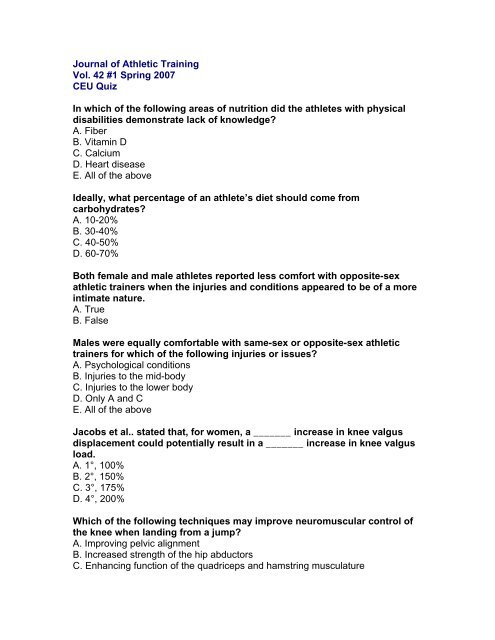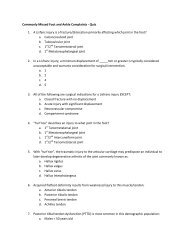Journal of Athletic Training Vol 42 #1 CEU Quiz Questions - National ...
Journal of Athletic Training Vol 42 #1 CEU Quiz Questions - National ...
Journal of Athletic Training Vol 42 #1 CEU Quiz Questions - National ...
Create successful ePaper yourself
Turn your PDF publications into a flip-book with our unique Google optimized e-Paper software.
<strong>Journal</strong> <strong>of</strong> <strong>Athletic</strong> <strong>Training</strong><strong>Vol</strong>. <strong>42</strong> <strong>#1</strong> Spring 2007<strong>CEU</strong> <strong>Quiz</strong>In which <strong>of</strong> the following areas <strong>of</strong> nutrition did the athletes with physicaldisabilities demonstrate lack <strong>of</strong> knowledge?A. FiberB. Vitamin DC. CalciumD. Heart diseaseE. All <strong>of</strong> the aboveIdeally, what percentage <strong>of</strong> an athlete’s diet should come fromcarbohydrates?A. 10-20%B. 30-40%C. 40-50%D. 60-70%Both female and male athletes reported less comfort with opposite-sexathletic trainers when the injuries and conditions appeared to be <strong>of</strong> a moreintimate nature.A. TrueB. FalseMales were equally comfortable with same-sex or opposite-sex athletictrainers for which <strong>of</strong> the following injuries or issues?A. Psychological conditionsB. Injuries to the mid-bodyC. Injuries to the lower bodyD. Only A and CE. All <strong>of</strong> the aboveJacobs et al.. stated that, for women, a _______ increase in knee valgusdisplacement could potentially result in a _______ increase in knee valgusload.A. 1°, 100%B. 2°, 150%C. 3°, 175%D. 4°, 200%Which <strong>of</strong> the following techniques may improve neuromuscular control <strong>of</strong>the knee when landing from a jump?A. Improving pelvic alignmentB. Increased strength <strong>of</strong> the hip abductorsC. Enhancing function <strong>of</strong> the quadriceps and hamstring musculature
D. All <strong>of</strong> the aboveIn the arm-cocked position, functional fatigue <strong>of</strong> the upper extremitydecreased acuity for which <strong>of</strong> the following joints?A. Glenohumeral, scapulothoracic, and elbowB. Glenohumeral, elbow, and wristC. Scapulothoracic, glenohumeral, and wristD. Scapulothoracic, elbow, and wristWhich <strong>of</strong> the following did Tripp et al. state is a reported mechanism bywhich fatigue affects the sensorimotor system?A. Changes occurring at the mechanoreceptor levelB. Desensitization <strong>of</strong> muscle spindlesC. Changes occurring at the central levelD. All <strong>of</strong> the aboveAccording to Higgins et al., which <strong>of</strong> the following statements is trueconcerning head impacts?A. The Severity Index <strong>of</strong> the headform center <strong>of</strong> gravity and mouthpiece are notsignificantly different.B. The Severity Index <strong>of</strong> the headform center <strong>of</strong> gravity and helmet are notdifferent from each other.C. G-force (g) measures <strong>of</strong> the headform and mouthpiece are not correlated.D. G-force (g) measures <strong>of</strong> the headform and mouth piece are not statisticallydifferent.What were the average impacts (g) Higgins et al. recorded at the headform,mouthpiece, and helmet, respectively?A. 98.85, 108.<strong>42</strong>, 278.38B. 0.869, 0.217, 0.789C. 409.77, 536.83, 2458.88D. 264.72, 324.57, 1321.64The conclusions reached by Johns et al. included:A. Clinicians should consider treatment values for individual ultrasoundtransducers.B. Power calibration should be considered and clinical adjustments made basedon individual machines.C. Stricter Food and Drug Administration standards are needed.D. All <strong>of</strong> the aboveAccording to Johns et al., which ultrasound unit did not show a differencebetween reported and measured effective radiating area values?A. ChattanoogaB. MettlerC. Omnisound
D. DynatronicsAverage lumbar spine position during walking and running was found byLevine et al. to be __________ uphill and ___________ downhill.A. Smallest, greatestB. Greatest, smallestLevine et al. found the largest total lumbar range <strong>of</strong> motion during whichcondition?A. Downhill standingB. Level walkingC. Uphill runningD. Downhill runningSwartz et al. reported what percentage <strong>of</strong> face masks were removable?A.100%B. 92%C. 84%D. 72%According to Swartz et al., which type <strong>of</strong> screw had the greatest successrate <strong>of</strong> removal from football helmets?A. SilverB. BlackC. GoldD. UnknownFatalities occurring due to spinal cord injury in football players havetypically resulted from:A. Participating in games.B. Participating in practices.C. Blocking.D. Tackling.Vertebral artery injuries can be seen:A. With cervical spine fractures only.B. With a fracture or fracture-dislocation <strong>of</strong> the spine.C. With a fracture or fracture-dislocation <strong>of</strong> the spine at or above the C-6vertebra.D. In individuals suffering from stroke.Wassinger et al. hypothesized that subjects would exhibit:A. Decreased shoulder active joint position replication.B. Decreased shoulder path <strong>of</strong> joint motion replication.C. Decreased functional performance.D. All <strong>of</strong> the above
Bressel et al. measured balance with which 2 tests?A. Single-leg stance and the Star Excursion Balance TestB. Balance Error Scoring System and the Star Excursion Balance TestC. Tandem stance on 2 different surfacesD. None <strong>of</strong> the aboveBressel et al. found that basketball players had lower Balance ErrorScoring System scores than gymnasts and higher Star Excursion BalanceTest scores than soccer players. The authors concluded that:A. Basketball players have better balance than gymnasts and soccer players.B. Basketball players have a lower risk <strong>of</strong> injury than gymnasts and soccerplayers.C. Basketball players have inferior static balance compared with gymnasts andinferior dynamic balance compared with soccer players.D. The differences in balance between athletes in different sports is notimportant.The Leadership Practices Inventory (LPI) measures which 5 leadershippractices?A. Model, Inspire, Challenge, Enable, EncourageB. Inspire, Enable, Challenge, Help, CritiqueC. Encourage, Assist, Prepare, Inspire, PushD. None <strong>of</strong> the aboveAccording to Laurent et al., compared with leaders in other fields, athletictrainers:A. Use modeling and enabling behaviors more than other leaders.B. Use inspiring and challenging behaviors less than other leaders.C. Use encouraging behaviors the same as other leaders.D. All <strong>of</strong> the aboveAccording to Weidner et al., which <strong>of</strong> these is NOT a positive outcome <strong>of</strong>Peer-Assisted Learning (PAL)?A. Improved communication skillsB. Decreased level <strong>of</strong> stress compared with working with instructorsC. Excellent accuracy in performing all skillsD. Increased confidence in decision-making skillsWeidner et al. concluded that Peer-Assisted Learning (PAL) should:A. Replace instruction by Approved Clinical Instructors.B. Be incorporated into athletic training education programs to enhance studentlearning.C. Not be used at all in athletic training education programs.D. Only be used for advanced-level students.Test-retest reliability reflects:
B. The intervention was only 4 weeks long.C. The intervention was performed on sedentary individuals.D. All <strong>of</strong> the above are limitations in this study.




